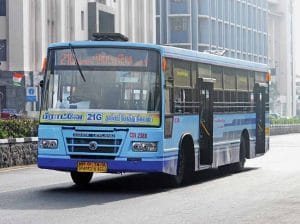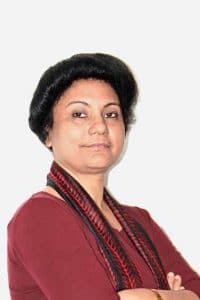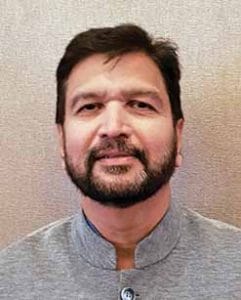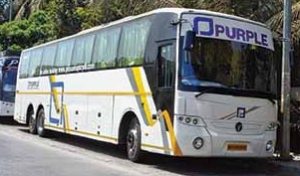Scaling public bus transport is necessary for sustainable development goals.
Story by Team CV
The impact of lockdown due to Covid-19 pandemic has been severe in the case of public bus transport in India. From March 2020 to July 2020, the revenue generation ability of public bus transport organisations was most affected. When operations resumed at the end of July 2020 or early August 2020, the challenges included a severely depleted working capital. Enjoying the status of an essential service at one end and grappling with numerous challenges at the other, the public bus transport organisations have been finding new ways to succeed since then. They are, according to Jan Deman, Director, Busworld, seeking new ways to get public funding. Stating that it is necessary to understand that no public transport would be sustainable without public funding, Deman mentioned that the pandemic has significantly changed the industry dynamics.

Emphasising that the private bus sector in India, which commands 80 per cent of the entire bus industry in India, too is in need of public funding to get back on its feet, Deman averred, “Public transport is clearly vulnerable and undervalued, and needs access to public funding.” Dr. Surendrakumar Bagde. General Manager, BrihanMumbai Electric Supply & Transport Undertaking (BEST), expressed that BEST buses proved to be of much use to essential-duty workers during the Covid-19 induced lockdown. He added that they have been successfully carrying out wet-lease operations in Mumbai through four operators and induction of 1000 buses. Of the opinion that it is necessary to provide sustainable and environmentally friendly public transport service, Dr. Bagde said that his organisation is looking to operate 10000 buses for Mumbai’s 20 million population. Looking at operating a fleet of 3000 buses on wet-lease, BEST is said to be looking at a fleet of 3337 buses by 2025.
Building sustenance
Claimed to work towards adding around 3500 buses on wet lease in its fleet, BEST has so far wet-leased mini and midi buses for conductor-less operation. These are engineered to work as a feeder service; as a last mile connectivity service that is aligned to the suburban train, metro and monorail network. Keen to increase bus services to elevate safer and greener mobility in the city for the masses, BEST, according to Dr. Bagde is looking at reducing CO2 vehicular emissions. Wet-lease, at the other, would boost private investment and provide better employment opportunities for the local population. Keen to make use of an Intelligent Transportation System (ITS) to improve operational efficiency and transparency, BEST, in the interest of sustenance and growth, is working towards bridging the supply and demand gap, which is estimated to be three to four times that of the international benchmarks. One of these is that a city should have 50 buses per lakh of population.
Working with the respective benchmark in mind, BEST as one of the oldest and most regarded public bus transport organisations, is also anticipating the dynamic needs of Mumbai city. Termed as the financial capital of India, Mumbai is also home to the Reserve Bank of India. Witnessing exponential growth in population over the last few decades as an island, Mumbai, according to Dr. Bagde is in need of a balance between public and private transport vehicles. As the second most preferred travel medium after suburban trains in Mumbai, BEST, he explained, is considered as a cost-effective travel medium with ease of access by the masses. Navigating past the challenge of high traffic density in Mumbai, BEST is working on ensuring timely operation of its buses on the routes designated.
Taking the bus
 Of the opinion that three-fourth of the current commuters are ready to continue, and another two-third of new commuters are ready to join if the service levels improve, Dr. Bagde, in terms of scaling up the public transport, said that as an organisation they are also taking stock of their infrastructure and the changes that will be needed in that area of operations. In the case of some public bus transport organisations, it is the infrastructure that has been a big revenue contributor. Informed Dr. Badge, that BEST has 27 depots and 108 bus terminals across Mumbai. He added that the organisation has a parking capacity of 6000 buses. The expansion of BEST’s fleet, considering this, would call for more parking space utilisation As per Dr. Badge’s calculation, the additional parking space utilisation in-line with the growth in fleet would be handled by five depots. Averred Karthick Athmanathan, SVP & Head e-Mobility, Ashok Leyland Limited, as if taking a que from Dr. Badge, that the bus industry in India is poised to accelerate. He said that the bus market volumes as per a survey by Ashok Leyland are 32000. These would rise to 57304 by FY 2030, he quipped.
Of the opinion that three-fourth of the current commuters are ready to continue, and another two-third of new commuters are ready to join if the service levels improve, Dr. Bagde, in terms of scaling up the public transport, said that as an organisation they are also taking stock of their infrastructure and the changes that will be needed in that area of operations. In the case of some public bus transport organisations, it is the infrastructure that has been a big revenue contributor. Informed Dr. Badge, that BEST has 27 depots and 108 bus terminals across Mumbai. He added that the organisation has a parking capacity of 6000 buses. The expansion of BEST’s fleet, considering this, would call for more parking space utilisation As per Dr. Badge’s calculation, the additional parking space utilisation in-line with the growth in fleet would be handled by five depots. Averred Karthick Athmanathan, SVP & Head e-Mobility, Ashok Leyland Limited, as if taking a que from Dr. Badge, that the bus industry in India is poised to accelerate. He said that the bus market volumes as per a survey by Ashok Leyland are 32000. These would rise to 57304 by FY 2030, he quipped.

Claiming that there will be a 40 per cent rise in e-buses by FY2029-30 with a TIV of 22148 units, Ananthanarayan said that issues like tendering, operating and finding right models to attract investors need to be looked into. He added that they have to be looked into in terms of real-world sustenance and an ability to scale up. Emphasising the need to snure bankable contracts and tender in view of the public bus transport organisations likely to command low credibility, Ananthanarayan said that a tender could be floated for routes, schedules and depots and not just for buses. They ought to be completely technology agnostic, he added. Suggesting public bus transport organisations to ensure that their routes, schedules, real estate and power supply are clearly defined and funded before tendering, Ananthanarayan mentioned that a subsidy in most cases is insufficient. In such a case, there is no cash to improve it either, he added.
Drawing the right plan
Of the opinion that there is a need for the government to increase the time depth of plans and orders, Ananthanarayan suggested that public bus transport organisations should draw a long-term roadmap for viability gap funding. Apart from refraining from a scheme-based approach, he added that a plan to add 50,000 e-buses in the next seven years should be chalked out. Stating that initial procurement of e-buses should be for longer routes to ensure sufficient cost advantage as compared to diesel buses, Ananthanarayan expressed that insufficient volumes would hamper not just costs, but localisation and the development of a competitive ecosystem too. Calling upon the public bus transport organisations to leverage technology to their advantage, he expressed that they should focus on services and solutions; on city transport planning to drastically increase public transit share. Informing that Ashok Leyland would come out with e-bus models in the next two years after evaluating the market needs, Ananthanarayan averred, “There is good scope for buses in India on the back of good transport planning.”

Anumita Roy Chowdhury, Executive Director, Research and Advocacy, Centre For Science and Environment, highlighted the change in the travel behaviour of the public due to the Covid pandemic. Stating that activities in residential areas increased by 29 per cent during lockdown, she stated that workplace travel reduced by 60 per cent. Retail and recreation visits also reduced by 84 per cent, she added. Emphasising on the change in walking and driving behaviour of the public in India, she suggested the same could be turned into an opportunity. “Post lockdown all trips reduced drastically, but walk trips increased and exceeded motorised trips,” he expressed. Claiming that travel trips of masses would double by 2030, Chowdhury said that daily travel trips would double. The share of public transport trips will decline from 26 per cent to 16 per cent, Chowdhury added. Informing that personal vehicles trips have increased from 34 per cent to 51 per cent and would have an effect on peak hour traffic, bringing speeds down to a crawl at 8km per hour from 16 km per hour, Chowdhury mentioned that bus ridership and fleet operations have declined significantly in recent times.
From sustenance to growth

Of the opinion that there is a need for public transport organisations to expand their fleet to move from sustenance to growth, Chodhury said that it would be the best way to secure good financial health. Stating that Delhi needs additional 13,243 buses to regain service capacity to the pre-lockdown level, she mentioned that protected bus lanes would be beneficial. Explaining that protected bus lanes would help reduce the number of buses needed from 13,243 to 1,0049, Chowdhury averred, “People are looking for safety in public transport. They are also looking for an improvement in service quality.” Revealing that 73 per cent people would like to shift to public transport (bus and metro) if high quality service is offered; service that meets global benchmark, Chowdhury said that urban regions with higher share of public transport ridership have been found to have lower emission levels.
Sharing data on megacities like Mumbai and Kolkata, which have a higher share of public transport ridership, Choudhary stated that between 2013 and 2018, 12 cities have lost combined ridership of 40.8 lakhs. She pointed at the National Transport Development Policy Committee (NTDPC) report, according to which, the passenger traffic would grow by 15-16 times over an economic growth of 7-9 per cent per annually. Of the opinion that India should invest 8 to 10 per cent of the GDP in transport infrastructure, she said that bus transport in India is already in deficit in terms of demand and supply situation. Mentioning that the traffic revenue reduced 48 per cent when the costs reduced by four-per cent, she said that a 69 per cent increase in annual VGF requirement of bus transport agencies in India was called for. Of the opinion that there are more than 10 different taxes being levied on bus services, of which MV tax contributes to approximately 20 per cent of total operational cost, Choudhary explained that the Government should tax burden on buses.
The right priorities
 Of the opinion that stress should be on moving people rather than on vehicle movement, Prasanna Patwardhan, Chairman & Managing Director, Prasanna Purple, and President, Bus Operators Confederation of India, said that there is a need to get the priorities right. He drew attention to 90 per cent of the Indians unable to afford their own vehicles. Stating that road development does not matter as much to them, Patwardhan mentioned that they are dependent almost entirely on public transport. In such a case, the allocation of not even five-per cent of transport budget for the development of public transport infrastructure reflects poorly on getting the priorities right, he added. Stressing that there is a disconnect between regulatory policies and their real-world implementation, Patwardhan averred that investment priorities also need to change. They need to be on the basis of per-person cost involving his or her travel from point-A to point-B.
Of the opinion that stress should be on moving people rather than on vehicle movement, Prasanna Patwardhan, Chairman & Managing Director, Prasanna Purple, and President, Bus Operators Confederation of India, said that there is a need to get the priorities right. He drew attention to 90 per cent of the Indians unable to afford their own vehicles. Stating that road development does not matter as much to them, Patwardhan mentioned that they are dependent almost entirely on public transport. In such a case, the allocation of not even five-per cent of transport budget for the development of public transport infrastructure reflects poorly on getting the priorities right, he added. Stressing that there is a disconnect between regulatory policies and their real-world implementation, Patwardhan averred that investment priorities also need to change. They need to be on the basis of per-person cost involving his or her travel from point-A to point-B.
Talking about infrastructure, taxation, financial support and integration, Patwardhan expressed that electric, green fuel, smart and connected vehicles need promotion. Drawing attention to the Bhopal Airport and Bus Station where his company is investing in, Patwardhan said that public and private bus transport organisations should work together to serve the large interest of the public. Revealing that his company is investing in infrastructure at Bhopal, Patwardhan averred that the government should give quality service and not impose high taxes. Tourist buses crossing multiple states pay taxes for all the states simultaneously, he said. Giving an example of Mumbai to Hyderabad bus which pays Rs.13.73 lakh tax per year per bus, Patwardhan explained that the government should invest more in public transport rather than to facilitate the movement of personal vehicles. It should facilitate the building of integrated transport solutions, he added.

Kulwant Singh Wilkhu, Director, Sutlej Motors Private Limited, said that the shift away from public transport vehicles was due to rising fares, taxes on private operators, high costs of vehicles and high service expectations. Of the opinion that technical, financial and legal challenges will always be there, Wilkhu averred, “There is still a need to link villages and satellite towns to urban regions of the country through public transport even today.” “Not all villages are connected yet, and if they are, the service quality is simply not up to the expectations,” he added. Informing that Sutlej is working on many projects by partnering with IITs
for electric, fuel cell and solar powered buses apart from other emerging technologies, Wilkhu said that one of the interesting projects includes the development of a virus free air circulation system on a bus. Confident that financial institutions including banks would make finance available for bus operators, Wilkhu expressed that there should be ease of doing bus business.


























